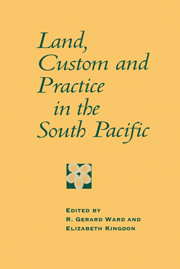Book contents
- Frontmatter
- Contents
- List of Figures
- List of Tables
- Contributors
- Acknowledgements
- Introduction
- 1 Land Use and Tenure: Some Comparisons
- 2 Land Tenure in the Pacific Islands
- 3 Breathing Spaces: Customary Land Tenure in Vanuatu
- 4 From Corporate to Individual Land Tenure in Western Samoa
- 5 Right and Privilege in Tongan Land Tenure
- 6 Land, Law and Custom: Diverging Realities in Fiji
- 7 Beyond the Breathing Space
- Bibliography
- Index
1 - Land Use and Tenure: Some Comparisons
Published online by Cambridge University Press: 10 November 2009
- Frontmatter
- Contents
- List of Figures
- List of Tables
- Contributors
- Acknowledgements
- Introduction
- 1 Land Use and Tenure: Some Comparisons
- 2 Land Tenure in the Pacific Islands
- 3 Breathing Spaces: Customary Land Tenure in Vanuatu
- 4 From Corporate to Individual Land Tenure in Western Samoa
- 5 Right and Privilege in Tongan Land Tenure
- 6 Land, Law and Custom: Diverging Realities in Fiji
- 7 Beyond the Breathing Space
- Bibliography
- Index
Summary
Land tenure in the Pacific Islands has always been subject to change. Even in pre-colonial times, which are sometimes portrayed as a time of stability and little change, land tenure practices were modified pragmatically to meet changing conditions, and control of land frequently passed from one group to another as a result of warfare, changing demographic pressures, or migration. Indeed, all tenure systems change over time, conditioned by broader socio-political shifts, demographic trends, technological and economic innovations, and alterations in the extent to which land is a scarce good. The current complexity and state of flux in the tenure arrangements for what is usually defined in the Pacific Islands either as ‘native land’ or ‘customary land’ is not unique. Comparable situations can be found in many other places and at many other times. One of the themes of this book is the occurrence in the Pacific Islands of particular cases of what is arguably a world-wide trend for communalistic forms of land tenure to be replaced by forms in which individual ownership plays a much greater role.
What makes the South Pacific Islands unusual is, first, the relatively recent occurrences of major changes in land tenure. Second, many of the changes have been unusually rapid. Third, national leaders in the region often refer to traditional land tenure as one of the important markers of national or cultural distinctiveness. At the same time a reluctance to acknowledge the extent to which the customary practices of today differ from those of a supposedly immemorial tradition is coupled with a willingness to ignore the divergence between current practices and the law where the conventions of land tenure have been codified.
- Type
- Chapter
- Information
- Land, Custom and Practice in the South Pacific , pp. 6 - 35Publisher: Cambridge University PressPrint publication year: 1995
- 1
- Cited by



